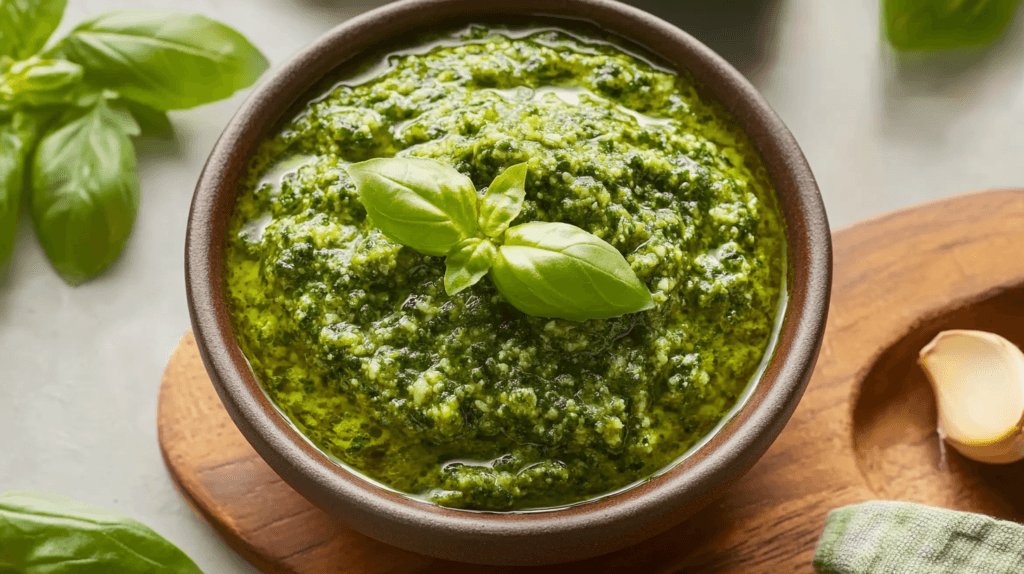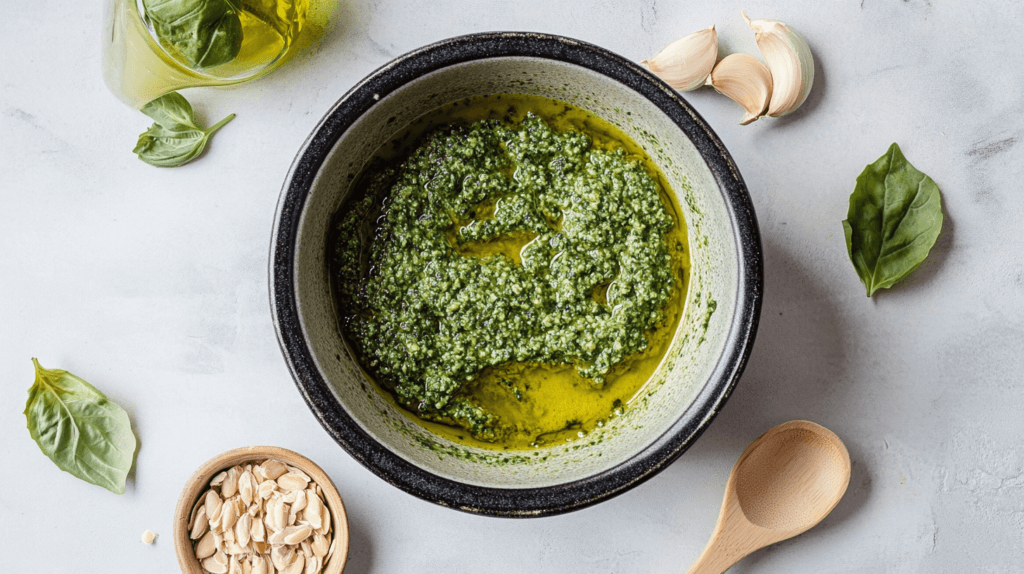Last updated on May 7th, 2025
Why Spinach Pesto is a Must-Try
When you think of Spinach Pesto Recipe, you probably picture the classic basil-based sauce with pine nuts and Parmesan cheese. But what if I told you there’s an even healthier, budget-friendly, and just-as-delicious alternative? Enter spinach pesto!
With My Experience as a Chef in Multiple Famous restaurents I can assure you that in this Article you will find the original and Healthier way to make it like a Chef !
Table of Contents
Health Benefits of Spinach Pesto Recipe
1. Loaded with Vitamins and Minerals
Spinach is a nutrient powerhouse. Just one serving of spinach pesto delivers:
✅ Vitamin A – Supports eye health
✅ Vitamin C – Boosts immunity
✅ Vitamin K – Essential for bone health
✅ Iron – Helps prevent anemia and keeps you energized
2. A Heart-Healthy Alternative to Traditional Pesto
Unlike classic basil pesto, which can be high in calories and fat, spinach pesto reduces the amount of oil and cheese without sacrificing flavor. This makes it a great choice for heart health.
3. High in Antioxidants
Spinach contains powerful antioxidants like lutein and zeaxanthin, which help reduce inflammation and fight free radicals that cause aging and disease.
4. Lower in Calories, Higher in Fiber
If you’re watching your calorie intake, spinach pesto is a great alternative. It’s naturally lower in fat and higher in fiber, which keeps you fuller for longer.
💡 Want more healthy meal ideas? Check out this Ultimate Vegan Soup Recipe, where you can use spinach pesto as a delicious garnish!
Essential Ingredients for Spinach Pesto Recipe
| Ingredient | Quantity | Why It’s Important |
|---|---|---|
| Fresh spinach | 2 cups (packed) | The base of the pesto—adds nutrients and a mild, earthy flavor. |
| Fresh basil | ½ cup | Balances the spinach with its classic pesto aroma. |
| Parmesan cheese | ½ cup (grated) | Adds a rich, salty, umami taste. |
| Garlic | 2 cloves | Gives a bold, spicy kick. |
| Pine nuts (or walnuts) | ¼ cup | Adds creaminess and nuttiness. |
| Extra virgin olive oil | ⅓ cup | Helps create a smooth and silky texture. |
| Lemon juice | 1 tablespoon | Brightens the flavors and prevents oxidation. |
| Salt | ½ teaspoon | Enhances all the ingredients. |
| Black pepper | ¼ teaspoon | Adds a mild spice to balance the flavors. |
Ingredient Substitutions & Variations
- Nut-Free Option – Swap nuts for sunflower seeds or skip them entirely.
- Dairy-Free/Vegan – Use nutritional yeast instead of Parmesan for a cheesy flavor.
- Extra Creamy Pesto – Add ½ an avocado for a rich, smooth texture.

Step-by-Step Guide to Making Spinach Pesto Recipe
Equipment Needed: Food Processor vs. Blender
- Best option: Food processor (creates the ideal texture).
- Alternative: Blender (may require more liquid to blend smoothly).
- Traditional method: Mortar and pestle (takes time but delivers incredible flavor!).
Step 1: Prep Your Ingredients
- Wash the spinach and basil thoroughly to remove any dirt or pesticides.
- Toast the nuts in a dry pan for 2-3 minutes until golden and fragrant. This enhances their natural oils and makes the pesto richer.
- Peel and roughly chop the garlic for easier blending.
Step 2: Blend the Base Ingredients
- In a food processor, combine the spinach, basil, garlic, nuts, and Parmesan cheese.
- Pulse for a few seconds until everything is roughly chopped.
Step 3: Add Olive Oil Slowly
- While the processor is running, slowly drizzle in the olive oil. This ensures a smooth, emulsified pesto rather than a chunky mess.
- Stop and scrape down the sides as needed.
Step 4: Adjust the Flavor
- Add lemon juice, salt, and black pepper.
- Taste and adjust—maybe you like more garlic or a bit more salt? Customize it to your preference!
Step 5: Blend Until Smooth
Blend until you reach your desired consistency. If it’s too thick, add a tablespoon of water or more olive oil. If it’s too thin, toss in a bit more spinach.
Step 6: Store or Serve Immediately
- If using immediately, mix it into pasta, spread it on toast, or use it as a dip.
- If storing, transfer to an airtight container and refrigerate for up to 5 days.
- For long-term storage, freeze it in an ice cube tray for quick portions later.
💡 Love easy meal prep? Try this Cheesy Garlic Zucchini Steaks recipe and serve it with a generous drizzle of spinach pesto!
Common Mistakes and How to Fix Them
1. Pesto is Too Bitter
✅ Too much garlic – Stick to one or two cloves max, or use roasted garlic for a milder taste
✅ Over-blended basil – Basil can release bitter compounds when over-processed. Pulse instead of blending continuously
✅ Low-quality olive oil – Some olive oils naturally taste bitter. Try using a mild, high-quality extra virgin olive oil
✅ Fix it: Add a pinch of sugar or a little more lemon juice to balance the bitterness
2. Pesto is Too Watery or Too Thick
✅ Too thin? Add more spinach, nuts, or cheese to thicken it
✅ Too thick? Drizzle in a little more olive oil or add a splash of water to loosen it up
3. Overpowering Garlic Flavor
✅ If your pesto tastes too sharp and spicy from garlic, try using roasted garlic instead of raw. It will give a sweeter, milder flavor
4. Pesto Turns Brown Too Quickly
✅ Oxidation makes pesto lose its vibrant green color. To prevent this:
- Always add lemon juice
- Store it in an airtight container with a thin layer of olive oil on top
- Keep it refrigerated and use it within 4-5 days
💡 Looking for another sauce-based recipe? Try this creamy and delicious Lobster Pasta Recipe—it pairs beautifully with a spoonful of spinach pesto!
Creative Variations of Spinach Pesto Recipe
1. Vegan Spinach Pesto
🌱 Swap Parmesan for:
- Nutritional yeast (for a cheesy, nutty flavor)
- Cashews or almonds (for extra creaminess)
2. Nut-Free Spinach Pesto
🥜 Replace nuts with:
- Sunflower seeds
- Pumpkin seeds
- Hemp seeds (adds protein!)
3. Spicy Spinach Pesto
🌶️ Love heat? Add:
- Red pepper flakes
- Jalapeño slices
- A dash of cayenne pepper
4. Protein-Packed Spinach Pesto
Want extra protein? Blend in:
- Chickpeas or white beans
- Greek yogurt (for a creamy, tangy twist)
💡 Looking for more healthy snack ideas? Check out Healthy Snacks for Kids at School, where you can use spinach pesto as a delicious dip!

Best Dishes to Pair with Spinach Pesto Recipe
1. Pasta Perfection 🍝
Toss spinach pesto with hot pasta like:
- Spaghetti (classic)
- Penne (holds sauce well)
- Orzo (great for salads)
💡 Pro Tip: Save some pasta water to mix into the pesto—it makes the sauce extra creamy!
2. Spinach Pesto as a Spread 🥪
Use it as a sandwich spread for:
- Grilled cheese
- Turkey wraps
- Avocado toast
3. Pizza Sauce Upgrade 🍕
Swap tomato sauce for spinach pesto and top with mozzarella and cherry tomatoes. Next-level delicious!
4. Salad Dressing 🥗
Thin it out with extra lemon juice and olive oil, and drizzle it over:
- Mixed greens
- Grilled chicken salad
- Quinoa bowls
5. Grilled Meats and Vegetables 🍖🌽
Brush pesto onto grilled chicken, salmon, shrimp, or roasted veggies for an instant flavor boost
💡 Want a delicious veggie side dish? Try these Cheesy Garlic Zucchini Steaks with a generous drizzle of spinach pesto!
How to Store and Preserve Spinach Pesto Recipe
1. Refrigeration (Short-Term Storage)
✅ Store in an airtight container in the fridge
✅ Pour a thin layer of olive oil on top to keep it fresh
✅ Lasts for: 4-5 days
2. Freezing (Long-Term Storage)
✅ Use an ice cube tray—freeze into small portions, then pop them into a bag
✅ Lasts for: 3-4 months
💡 Pro Tip: When ready to use, thaw in the fridge or toss a frozen pesto cube directly into hot pasta!
FAQs About Spinach Pesto Recipe
1. Why Is My Spinach Pesto Bitter?
Bitter pesto can happen for several reasons, but the good news is that it’s easy to fix!
✅ Over-blended basil – Basil contains natural compounds that can turn bitter when over-processed. Try pulsing the ingredients instead of blending them continuously.
✅ Low-quality olive oil – Some extra virgin olive oils have a naturally bitter aftertaste. Use a milder, high-quality olive oil to avoid this.
✅ Too much garlic – Raw garlic has a strong, sometimes bitter bite. Reduce the amount or use roasted garlic for a milder flavor.
✅ Fix it: Add a little honey, sugar, or extra lemon juice to balance out the bitterness.
2. Can You Substitute Spinach for Basil in Pesto?
Absolutely! Spinach is a fantastic alternative to basil in pesto. In fact, some people prefer it because it’s milder in flavor and less expensive than fresh basil.
✅ Spinach gives pesto a slightly sweeter, earthier taste compared to basil’s peppery, aromatic flavor.
✅ If you love the traditional basil taste, use a half-and-half mix of spinach and basil for balance.
✅ You can also swap in kale, arugula, or parsley for different flavor profiles.
💡 Want to explore more pesto pairings? Try this Lobster Pasta Recipe and add a spoonful of spinach pesto for a fresh twist!
3. Why Does My Homemade Pesto Taste Bad?
If your homemade pesto tastes off, it could be due to one or more of these reasons:
✅ Too much garlic – If the garlic flavor is too strong, try using one clove instead of two or roasting the garlic before adding it.
✅ Rancid nuts – Pine nuts, walnuts, and other nuts can turn rancid if stored for too long. Always use fresh nuts for the best taste.
✅ Bitter olive oil – Some extra virgin olive oils have a bitter taste. If your pesto tastes unpleasant, switch to a milder oil.
✅ Oxidation – Pesto can turn dark and develop a strange taste if exposed to too much air. Always store pesto with a layer of olive oil on top in an airtight container.
4. What Is a Substitute for Pine Nuts in Pesto?
If you don’t have pine nuts, don’t worry! There are plenty of delicious and affordable substitutes.
✅ Almonds – Slightly sweet with a mild crunch
✅ Walnuts – Earthy and slightly bitter, great for a richer pesto
✅ Cashews – Creamy and buttery, perfect for a smooth texture
✅ Sunflower seeds – A nut-free option that still adds texture
✅ Pumpkin seeds – A great alternative with a mild, nutty taste
💡 Looking for more healthy meal inspiration? Check out Healthy Snacks for Kids at School, where spinach pesto can be used as a nutritious dip!
5. Can I Use Frozen Spinach for Pesto?
Yes, but with a few extra steps! Frozen spinach contains a lot of water, which can make your pesto too thin. To fix this:
✅ Thaw the spinach completely
✅ Squeeze out all excess water using a kitchen towel
✅ Use a little less olive oil, since frozen spinach won’t absorb it as much as fresh spinach
6. How Long Does Homemade Pesto Last?
✅ In the fridge: 4-5 days in an airtight container with a thin layer of olive oil on top
✅ In the freezer: 3-4 months when frozen in ice cube trays for easy portioning
7. How Can I Keep My Pesto Green?
To prevent oxidation and keep your pesto looking vibrant green, follow these tips:
✅ Add lemon juice – The acidity helps prevent discoloration
✅ Store in an airtight container – Less air means less oxidation
✅ Cover with a layer of olive oil – This creates a barrier against air exposure
8. What’s the Best Pasta to Serve with Spinach Pesto?
Spinach pesto pairs well with almost any pasta, but these are the best options:
✅ Spaghetti – Classic and easy to coat with pesto
✅ Penne – Holds onto the sauce perfectly
✅ Orzo – Ideal for pasta salads
✅ Fettuccine – Creates a creamy, rich dish
9. Can I Make Pesto Without Cheese?
Yes! To make a dairy-free or vegan pesto, simply swap out Parmesan cheese for:
✅ Nutritional yeast – Adds a cheesy, umami flavor
✅ Cashews or almonds – Create a creamy texture
✅ A little extra lemon juice and salt to enhance the overall taste
💡 Want a unique way to enjoy pesto? Try it on these Cheesy Garlic Zucchini Steaks for a flavorful twist!
10. Can I Use Pesto on More Than Just Pasta?
Definitely! Pesto is one of the most versatile sauces you can make. Try it as a:
✅ Sandwich spread – Use it in grilled cheese, turkey wraps, or avocado toast
✅ Pizza sauce – Swap out traditional tomato sauce for pesto
✅ Salad dressing – Mix with lemon juice and olive oil for a zesty dressing
✅ Marinade – Brush onto chicken, shrimp, or salmon before grilling
✅ Dip – Perfect for roasted veggies, crackers, or even scrambled eggs
Spinach pesto is an easy, delicious way to add flavor to so many dishes. Give it a try, and don’t be afraid to experiment! 😊
Why Spinach Pesto Should Be a Staple in Your Kitchen
Spinach pesto is easy to make, healthy, and ridiculously delicious. Whether you’re using it for pasta, sandwiches, or even pizza, it’s a versatile sauce that belongs in every kitchen
Plus, it’s budget-friendly, packed with nutrients, and totally customizable to fit your dietary needs. So why not try making a batch today?

